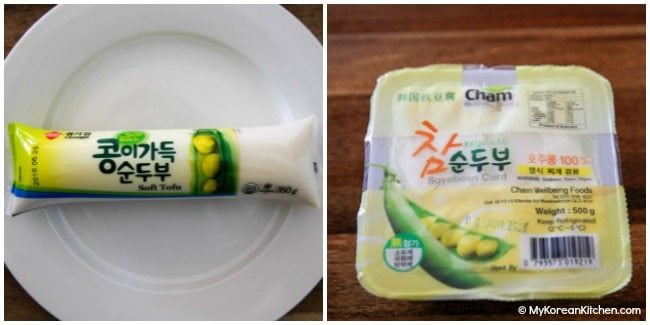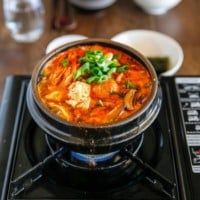
Today I want to share a popular Korean stew – Sundubu Jjigae or Soondubu Jjigae (순두부 찌개, Korean spicy soft tofu stew) recipe.
I think sundubu jjigae is one of the top 3 sought after Korean stews, along with kimchi jjigae and doenjang jjigae. (“Jjigae” means stew in Korean.) If you haven’t checked out those two recipes yet, you should! They are two of my most popular Korean soup recipes as well.

What is Sundubu Jjigae (Korean Spicy Soft Tofu Stew)
Sundubu jjigae is a Korean stew made with soft (uncurdled) tofu as a highlight ingredient.
There are a few different ways to make sundubu jjigae using different ingredients (e.g. kimchi, minced pork and seafood) but by far my favorite version is the seafood version known as Haemul Sundubu Jjigae (해물 순두부 찌개). You can really taste the refreshing and clear tasting soup.
In general, sundubu jjigae is a bit spicy though I think my recipe is in the modest pepper scale. Nevertheless, the spiciness of the stew can vary depending on the types of chili powder / chili flakes you use. Also, whether you used chili oil or neutral oil. A spicier version can potentially make you sneeze while you’re cooking and may even tickle your throat.
Nonetheless, it’s a refreshing, delicious and very comforting stew you can enjoy any time of the year!
Watch How I Make Sundubu Jjigae (Video)
Variations and Tips
- Soft Tofu
I want to highlight that there are two different types of soft tofu available at a Korean grocery store. The most common one is packaged in a long cylinder shape plastic bag and the other one is packaged in a regular tofu plastic container.
I personally prefer to work with the cylinder shape soft tofu because it’s easier and quicker to add to the soup/stew. But you can use either one for this stew.

- Korean Chili Oil
Korean chili oil is commonly used when you make spicy soup such as today’s recipe or yukgaejang (spicy beef soup) etc. It adds nice bright red color to the dish and it brings out the rich depth of flavor. You can certainly make sundubu jjigae without it, but I love the outcome when I add it.
Check my homemade Korean chili oil recipe. Alternatively, you can also use store bought Korean chili oil instead.
I also have tried this S&B La-Yu chili oil in sundubu jjigae and it worked well. This oil is actually a bit spicier than my homemade chili oil and gives less depth of flavor and color.
- Korean Chili Powder vs Korean Chili Flakes
Korean chili powder is a finer version of Korean chili seasoning than Korean chili flakes. Ultimately you can use either types of chili seasonings in this recipe. However, you will notice that when you use Korean chili powder, the color of the stew is more vibrantly red than when you use chili flakes. It makes the stew look simply more appetizing.
- Pot
Make sure your pot is large enough to hold all the ingredients listed below, otherwise it can boil over. As an indicator, my 1.7 L pot (as seen on the video above) holds the ingredients quite comfortably (no boiling over!).
Ingredients for Sundubu Jjigae, 2 to 3 servings

Main
- 350g/12 ounces Korean soft tofu (sundubu)
- 110g/3.9 ounces littleneck clams or pipis, cleaned
- 3-4 banana prawns (80g/2.8 ounces), head, shells and guts removed
- 100g/3.5 ounces enoki mushrooms, bottom 4-5 cm stem removed and rinsed briefly in cold running water
- 2 small shiitake mushrooms (20g/ 0.7 ounces), cleaned, stem removed and thinly sliced
- 1 egg
- 1 stalk of green onion (10g/0.4 ounces), thinly sliced
Soup base
- 1.5 cups dried kelp and anchovy stock
- 1 Tbsp Korean chili oil or neutral cooking oil
- 2 Tbsp Korean chili powder or Korean chili flakes (gochugaru)
- 1 tsp minced garlic
- 1/2 Tbsp Korean fish sauce
- 1/2 Tbsp Korean soup soy sauce or regular kikkoman soy sauce
- fine sea salt, to taste
- A few sprinkles of ground black pepper
- A dash (about 1/2 tsp) of sesame oil
* 1 Tbsp = 15 ml
** If you want to learn more about Korean ingredients, check my essential Korean cooking ingredients list!
How to Make Sundubu Jjigae
1. Start heating the pot on the stove over medium low heat and add the chili oil, chili powder, and garlic. Stir them well for about 1 min. Make sure not to burn the chili powder.

2. Add the clams and shrimps and stir quickly to coat them with the chili sauce. Add the fish sauce and soy sauce then stir.

3. Add the dried kelp and anchovy stock and boil it on medium-high heat until it starts to boil rapidly (2 to 3 mins).

4. Add the tofu, mushrooms, and egg and cook them for another 2 to 3 mins. Season with salt, if required.

5. Top up with the green onion, black pepper and sesame oil. Serve hot with Korean rice and side dishes (banchan).

Love Korean food? Browse lots more Korean recipes from my easy Korean recipe collections. And subscribe to my newsletter and follow along on Facebook, Pinterest and Instagram for all of the latest updates.

Sundubu Jjigae (Korean Spicy Soft Tofu Stew)
Ingredients
Main
- 350 g Korean soft tofu (12 ounces)
- 110 g littleneck clams (3.9 ounces), cleaned
- 3-4 banana prawns (80g / 2.8 ounces), head, shells and guts removed
- 100 g enoki mushrooms (3.5 ounces), bottom 4-5 cm stem removed and rinsed briefly in cold running water
- 2 shiitake mushrooms (20g / 0.7 ounces), cleaned, stem removed and thinly sliced
- 1 egg
- 1 stalk green onion (10g / 0.4 ounces), diagonally thinly sliced
Soup base
- 1.5 cups Dried kelp and dried anchovy stock
- 1 Tbsp Korean chili oil or neutral cooking oil (e.g. rice bran oil)
- 2 Tbsp Korean chili powder or Korean chili flakes(gochugaru)
- 1 tsp minced garlic
- 1/2 Tbsp Korean fish sauce
- 1/2 Tbsp soy sauce , kikkoman regular or Korean soup soy sauce
- fine sea salt , to taste
- A few sprinkles ground black pepper
- A dash sesame oil , about 1/2 tsp
Instructions
- Start heating the pot on the stove over medium low heat and add the chili oil, chili powder, and garlic. Stir them well for about 1 min. Make sure not to burn the chili powder.
- Add the clams and shrimps and stir quickly to coat them with the chili sauce. Add the fish sauce and soy sauce then stir.
- Add the dried kelp and anchovy stock and boil it on medium-high heat until it starts to boil rapidly (2 to 3 mins).
- Add the tofu, mushrooms, and egg and cook them for another 2 to 3 mins. Season with salt, if required.
- Top up with the green onion, black pepper and sesame oil. Serve hot with Korean rice and side dishes (banchan).
Notes
- 1 Tbsp = 15 ml
- If you want to learn more about Korean ingredients, check my essential Korean cooking ingredients list!
Nutrition Info (per serving)
The nutrition information shown is an estimate provided by an online nutrition calculator. It should not be considered a substitute for a professional nutritionist’s advice.



